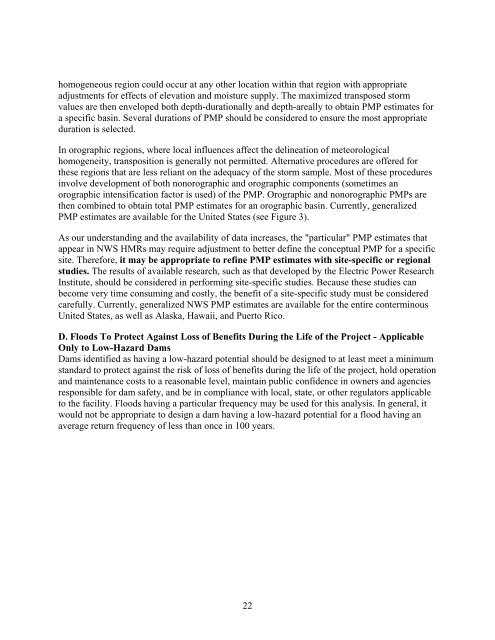Federal Guidelines for Dam Safety: Selecting and Accommodating
Federal Guidelines for Dam Safety: Selecting and Accommodating
Federal Guidelines for Dam Safety: Selecting and Accommodating
You also want an ePaper? Increase the reach of your titles
YUMPU automatically turns print PDFs into web optimized ePapers that Google loves.
homogeneous region could occur at any other location within that region with appropriate<br />
adjustments <strong>for</strong> effects of elevation <strong>and</strong> moisture supply. The maximized transposed storm<br />
values are then enveloped both depth-durationally <strong>and</strong> depth-areally to obtain PMP estimates <strong>for</strong><br />
a specific basin. Several durations of PMP should be considered to ensure the most appropriate<br />
duration is selected.<br />
In orographic regions, where local influences affect the delineation of meteorological<br />
homogeneity, transposition is generally not permitted. Alternative procedures are offered <strong>for</strong><br />
these regions that are less reliant on the adequacy of the storm sample. Most of these procedures<br />
involve development of both nonorographic <strong>and</strong> orographic components (sometimes an<br />
orographic intensification factor is used) of the PMP. Orographic <strong>and</strong> nonorographic PMPs are<br />
then combined to obtain total PMP estimates <strong>for</strong> an orographic basin. Currently, generalized<br />
PMP estimates are available <strong>for</strong> the United States (see Figure 3).<br />
As our underst<strong>and</strong>ing <strong>and</strong> the availability of data increases, the "particular" PMP estimates that<br />
appear in NWS HMRs may require adjustment to better define the conceptual PMP <strong>for</strong> a specific<br />
site. There<strong>for</strong>e, it may be appropriate to refine PMP estimates with site-specific or regional<br />
studies. The results of available research, such as that developed by the Electric Power Research<br />
Institute, should be considered in per<strong>for</strong>ming site-specific studies. Because these studies can<br />
become very time consuming <strong>and</strong> costly, the benefit of a site-specific study must be considered<br />
carefully. Currently, generalized NWS PMP estimates are available <strong>for</strong> the entire conterminous<br />
United States, as well as Alaska, Hawaii, <strong>and</strong> Puerto Rico.<br />
D. Floods To Protect Against Loss of Benefits During the Life of the Project - Applicable<br />
Only to Low-Hazard <strong>Dam</strong>s<br />
<strong>Dam</strong>s identified as having a low-hazard potential should be designed to at least meet a minimum<br />
st<strong>and</strong>ard to protect against the risk of loss of benefits during the life of the project, hold operation<br />
<strong>and</strong> maintenance costs to a reasonable level, maintain public confidence in owners <strong>and</strong> agencies<br />
responsible <strong>for</strong> dam safety, <strong>and</strong> be in compliance with local, state, or other regulators applicable<br />
to the facility. Floods having a particular frequency may be used <strong>for</strong> this analysis. In general, it<br />
would not be appropriate to design a dam having a low-hazard potential <strong>for</strong> a flood having an<br />
average return frequency of less than once in 100 years.<br />
22

















